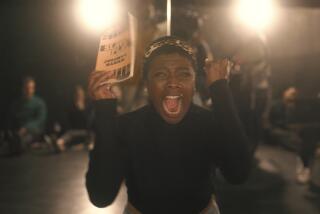STAGE REVIEW : DELICATE HARRIS TOUCH AT WORK IN ‘BRONTE’
- Share via
Julie Harris, with no fanfare, has quietly been unfolding a one-woman dramatization of Charlotte Bronte in one-night stands at colleges and selected theaters around town for the last several weeks.
It’s rare to see Harris on stage here, and it’s rarer still that a major performer has been playing to big houses with such scant press attention. The creative team is the same trio that staged the one-woman Emily Dickinson Broadway success “The Belle of Amherst” (Harris, playwright/adapter William Luce and director Charles Nelson Reilly).
Harris is testing “Bronte: A Solo Portrait of Charlotte Bronte” “to see just how far it will go and where it will go,” she said after Saturday night’s performance before some 800 people at Beckman Auditorium on the Caltech campus.
It’s a performance marked by particular clarity and Harris’ distinctive emotional register. The production enjoys a fine period texture (the year is 1849), and it brings alive that remarkable and insular Bronte clan with some fascinating insights, particularly about Charlotte’s expressed longing for love and her re-enactments of the sisters’ turmoil with their dissolute, opium-addicted brother, Branwell.
The drama occurs in the course of a single day in a sitting room of the Bronte house. The old stone parsonage is redolent of death. Sister Emily and brother Branwell are recently deceased. The parsonage, on a brooding Yorkshire moor, is bounded on three sides by a cemetery. And Charlotte is just returning home after burying her younger sister, Anne.
Suddenly, at 33, Charlotte, already the author of “Jane Eyre,” is left alone--all her loved ones gone--to care for an eccentric father in comparative social isolation.
Harris, with some touches of irony and humor, catches both Charlotte’s determination not to be “crushed” and her delicacy.
The delivery alternates between addresses directly to the audience and imaginary conversations to unseen figures in a chair or through a doorway (such as her pastor father, a maid, re-enactments of scenes with deceased family members).
In sum, Harris becomes the tremulous measure of the moody moors we don’t see but feel, of “a clock ticking loud through a still house.”
Much of the material is taken from Charlotte’s own reminiscences: “What did our lives mean?” she muses. “What did we give each other? What were we?”
In one precious scene, Harris is Charlotte playing a little girl playing war with Branwell’s toy soldiers. In another, we see the sisters trooping to their publisher to expose their noms de plume (Currer, Ellis and Acton Bell for, respectively, Charlotte’s “Jane Eyre,” Emily’s “Wuthering Heights” and Anne’s “Agnes Grey”). As Charlotte explains: “We had a vague impression that authoresses are liable to be looked on with prejudice.” This is comparatively exotic material for general audiences, but then so was “The Belle of Amherst” (which won Harris her fifth Tony). The introspective nature of the piece has been admirably opened up.
Harris, long smitten with the work and life of Charlotte Bronte, first did “Bronte” for public radio and, after a handful of local benefit performances, shot it as a film (Delbert Mann directing) in 1982 in Ireland. It was aired by PBS in 1985.
Additional performances will be at Cal State Long Beach on March 7 and at Cal State Fullerton March 28.
More to Read
The biggest entertainment stories
Get our big stories about Hollywood, film, television, music, arts, culture and more right in your inbox as soon as they publish.
You may occasionally receive promotional content from the Los Angeles Times.










